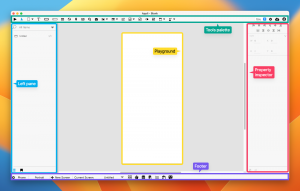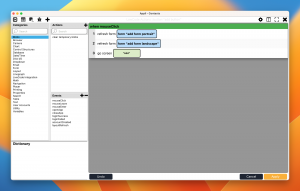Three decades ago, building a digital product meant having a team of expert developers who were writing thousands of lines of code in C++ or Java (or similar low-level language) and dealing with complex issues like memory management and hardware integration.
Two decades ago, with languages like Python, the process became more accessible. Still, it took significant technical expertise and an understanding of underlying systems. Developers had to set up servers, manage databases, and ensure their apps could scale.
Today, with low-code and no-code platforms, anyone can build a digital product. Through a visual interface, you can now drag and drop elements to design apps, automate workflows, and integrate various functionalities without diving into coding complexities.
Simply put, low-code and no-code allow us to focus on what really matters: the design, the user experience, and the core functions. It’s less about wrestling with complex code and more about bringing your creative vision to life. Naturally, this opens up the world of app creation to a much wider audience: Entrepreneurs, teachers, artists, and anyone with a drive to innovate or solve problems can now step into the role of a software developer.
Let’s explore the transformative power of low-code and no-code in more detail.

Benefits of low-code & no-code
Low-code and no-code are all about making app development accessible to more people and speeding up the process from idea to actual app—by up to 90% compared to traditional development methods. They are great for everything from a basic app to keep track of your daily tasks to more complex systems that businesses rely on to handle things like customer data and internal workflows.
Here’s a bit more about what sets these two types of approaches apart:
No-code platforms utilize a visual development environment to allow non-technical users to create applications by dragging and dropping software components to create a full-fledged application. Often, their priority is to be user-friendly and intuitive.
Low-code platforms also tend to have a visual approach to development but require some degree of coding knowledge. They are designed to reduce the amount of hand-coding and can be used to create more complex applications.
Whether you’re a small business owner looking to streamline your operations or a creative type wanting to bring a new app to life, low-code and no-code platforms can be of big help.
How to learn low-code & no-code
Stepping into low-code and no-code development is often like unlocking a new creative power. Here are some tips on how to get started and keep improving:
- Get to know your tools: Spend time exploring and understanding the platform you choose to work with. Each one, like Appli, has its own set of commands and shortcuts. Learning about these can help you do more with less effort.
- Think like a developer: Even though coding isn’t required, adopting a developer’s mindset can help. This means thinking logically, planning your application’s structure, and being methodical in your approach.
- Leverage community and resources: Most low-code/no-code platforms have active communities and a wealth of online resources. Engaging with these to seek feedback or ask questions can provide valuable insights and support.
- Practice and experiment: There’s no better way to learn than by doing. Start with simple projects to get a feel for the platform and gradually take on more complex challenges as you become more confident. Don’t be afraid to make mistakes—it’s all part of the learning process!
- Stay sharp: The landscape of low-code and no-code development is dynamic, with new features, tools, and best practices emerging regularly. Keep up with the latest updates and features to keep your skills fresh.

Appli’s low-code interface.
At Appli, we believe everyone can become a developer. Download our platform for free and get started building your first project!
Low-code & no-code challenges
While low-code and no-code platforms are powerful, they’re no magic wands. Particularly for projects with specific or complex requirements, these platforms may have certain limitations. Integration with existing systems, for example, can sometimes require additional effort to ensure everything runs smoothly.
Security is another big thing to keep an eye on. The ease of use provided by these platforms shouldn’t distract from the need to keep your applications and data secure.
Despite these issues, exploring low-code and no-code is definitely worthwhile. As the different platforms and solutions keep growing and improving, they’re going to open up even more possibilities. For now, it’s all about finding your way around the platform you’re using, figuring out what you can do with it, and sometimes getting a bit creative when you hit a roadblock.
At Appli, we’re here to empower your journey from idea to innovation. Got questions about navigating low-code or no-code? Dive into our community forum or reach out directly.







